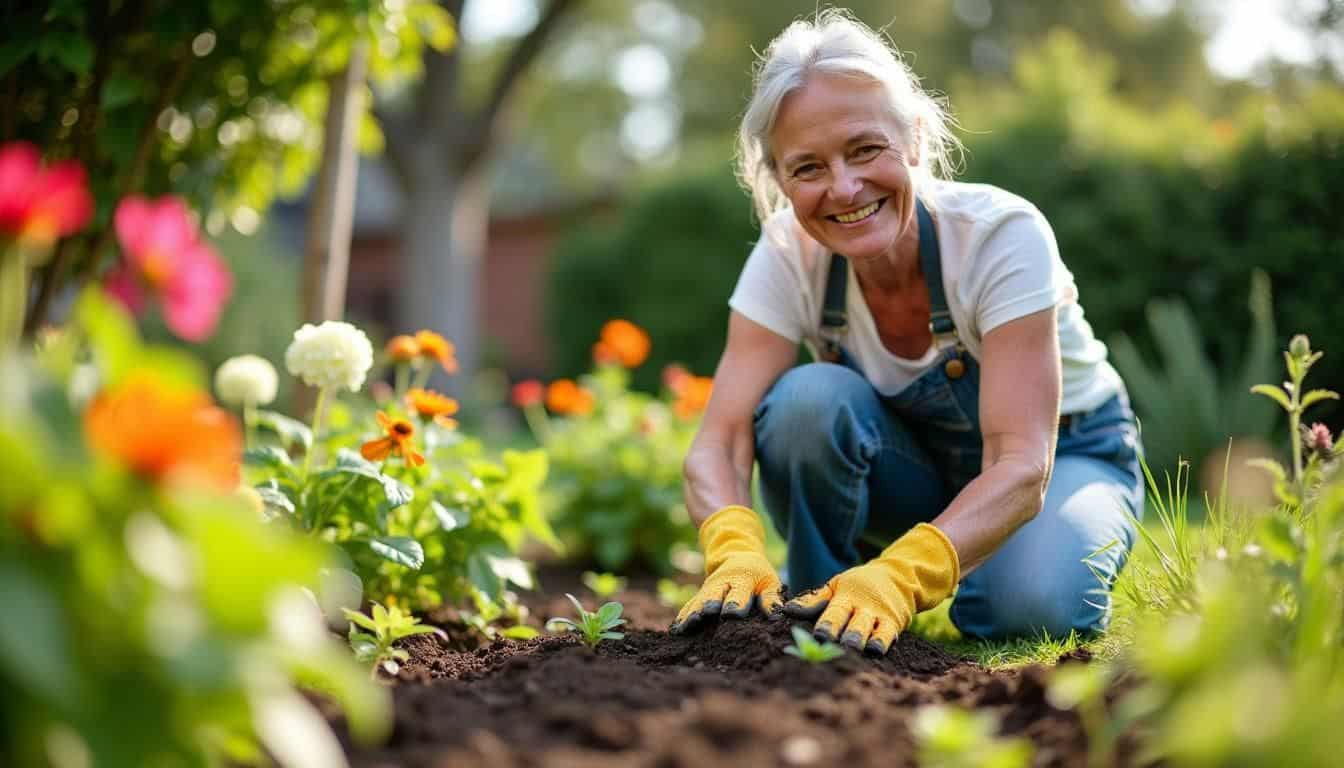Ever dreamed of growing your own veggies but felt lost in a jungle of gardening advice? You’re not alone. Did you know that gardening can slash your grocery bill by up to 25%? 3 This article will give you 12 easy-to-follow tips to kickstart your green adventure.
Ready to dig in? 1
Key Takeaways
Choose a sunny spot with good soil for your garden. Most veggies need at least 6 hours of direct sunlight daily.
Test your soil and add compost to improve its quality. This can boost plant health and reduce the need for fertilizers.
Start seeds indoors 6-10 weeks before the last frost to get a head start on the growing season.
Water deeply but less often to encourage strong root growth. Stick your finger in the soil – if it’s dry 2 inches down, it’s time to water.
Mulch helps control weeds and retain moisture. Use organic options like compost or straw, which also feed the soil as they break down.
Table of Contents
Selecting the Optimal Garden Location
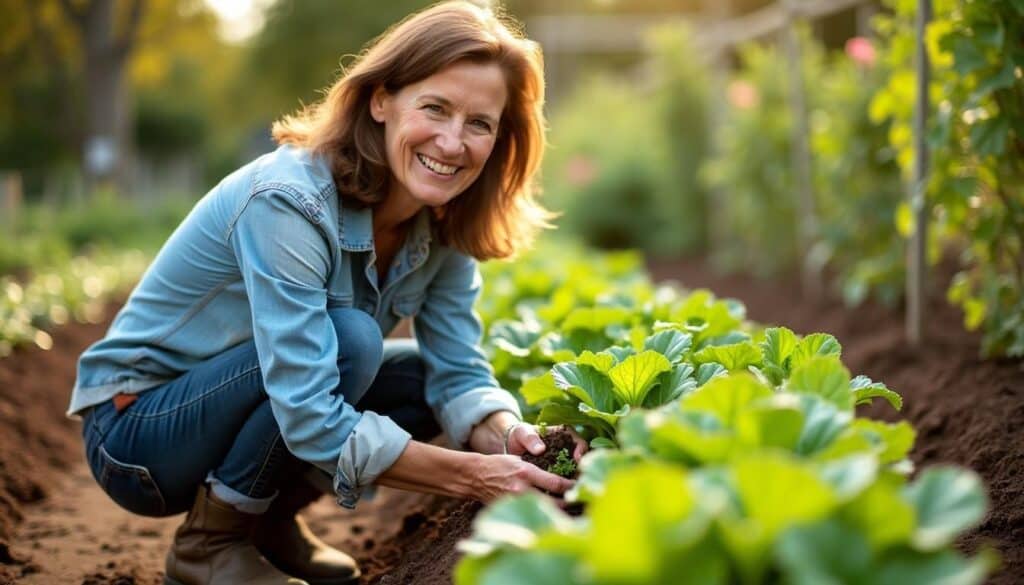
Finding the right spot for your garden is key. Look for a place with plenty of sun and good soil – it’ll make your plants happy campers.
Assessing sunlight exposure, soil type, and accessibility
Picking the right spot for your garden is key. You’ll want a place that gets plenty of sun – most veggies need at least 6 hours of direct light daily. Check out your yard at different times to see where the sunny spots are.
Don’t forget about soil! Grab a handful and give it a squeeze. If it holds shape but crumbles easily, you’ve struck gold. Sandy or clay-heavy dirt? No sweat – you can fix that with some compost. 1
Easy access is a must too. You don’t want to trek across your whole yard just to water your plants. Put your garden near a water source if you can. And think about how you’ll get your tools there.
A spot close to your shed or garage is ideal. Trust me, lugging heavy watering cans isn’t fun – I learned that the hard way! 2
Choosing Plants for Your Garden
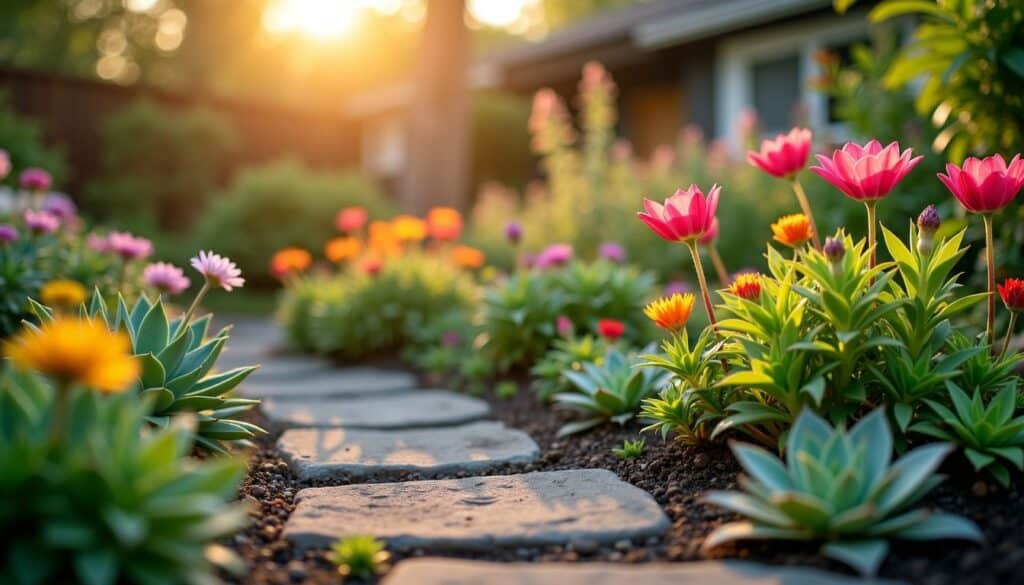
Picking the right plants can make or break your garden. It’s like choosing teammates for a game – you want the best fit for your space and climate. Wanna know how to pick winners? Keep reading!
Options for vegetables, fruits, herbs, and flowers
Ready to dig in? Let’s talk garden goodies. You’ve got lots of options for your green space. Veggies like cucumbers, lettuce, peppers, and tomatoes are great starters. They’re easy to grow and pack a punch in the kitchen. 3 For a splash of color, try some annuals – marigolds, sunflowers, or zinnias will brighten up any patch.
Don’t forget about herbs! They’re perfect for small spaces and add flavor to your meals. 4 Mediterranean herbs love the sun, so give ’em a prime spot. And if you want something that comes back year after year, perennials are your best bet.
Black-eyed Susans and purple coneflowers are tough cookies that’ll keep your garden buzzing with bees. The key is to grow your own food and flowers that suit your taste and space.
A garden is a grand teacher. It teaches patience and careful watchfulness; it teaches industry and thrift; above all, it teaches entire trust. – Gertrude Jekyll
Considerations for climate and space availability
Climate and space are key factors in garden planning. Your local weather patterns and USDA zone will guide plant choices. 5 Hot areas might suit tomatoes and peppers, while cool spots favor leafy greens.
Space matters too. A 10′ x 10′ plot is great for newbies. Don’t cram plants – leave room for growth and paths. Every four feet, add a walkway for easy access. This setup lets you tend your oval planters without stepping on plants.
Think about sun exposure when picking spots. Most veggies need 6-8 hours of direct light daily. Shade-lovers like lettuce can thrive in less sunny areas. Soil type plays a role too.
Sandy soil drains fast, while clay holds water longer. Match your plants to these conditions for the best results. 6 With smart planning, even small spaces can yield a bountiful harvest.
Soil Preparation Steps
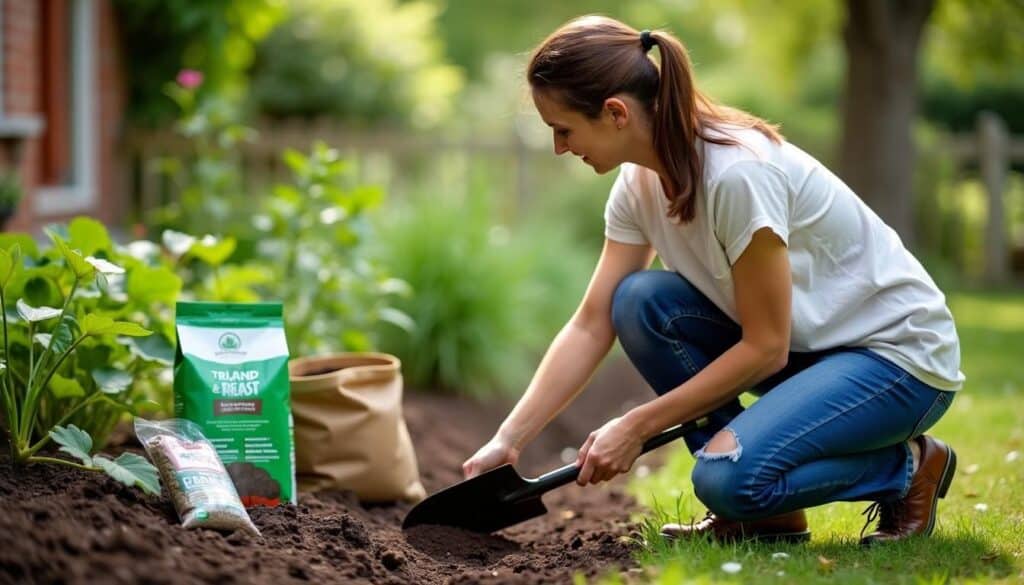
Soil prep is key to a thriving garden. It’s like setting a good foundation for your house. Get your hands dirty and test that soil! Add some compost, maybe a dash of fertilizer… and voila! Your plants will thank you.
Want to know more about making your soil happy? Keep reading!
Conducting soil quality tests
Guys, let’s talk dirt – literally. Testing your soil is like giving your garden a health check-up. It’s not fancy, but it’s key to growing killer veggies and flowers. Grab a soil test kit from your local garden store.
It’s easy to use and will tell you what your soil needs. The test shows nutrient levels and pH balance. This info helps you feed your plants right and avoid wasting money on stuff they don’t need. 8
Don’t skip soil tests – they’re a game-changer. Do them every year or two to keep tabs on your soil’s health. It’s like getting your car’s oil checked regularly. Good soil means happy plants, and that means a garden that’ll make your neighbors jealous.
Plus, you’ll be doing Mother Nature a solid by not over-fertilizing. It’s a win-win, fellas. 7
Improving soil with organic compost and fertilizers
Good soil is key to a great garden. Mix in organic compost to boost your dirt’s health. It’s like giving your soil a vitamin shake! Toss in some coconut coir or green waste compost.
These goodies help your soil hold water and feed your plants. Don’t forget fertilizers – they’re the secret sauce for plant growth. But first, test your soil. This tells you what nutrients it needs.
Then pick a fertilizer with the right NPK ratio. That’s the mix of nitrogen, phosphorus, and potassium your plants crave.
Designing Your Garden Layout
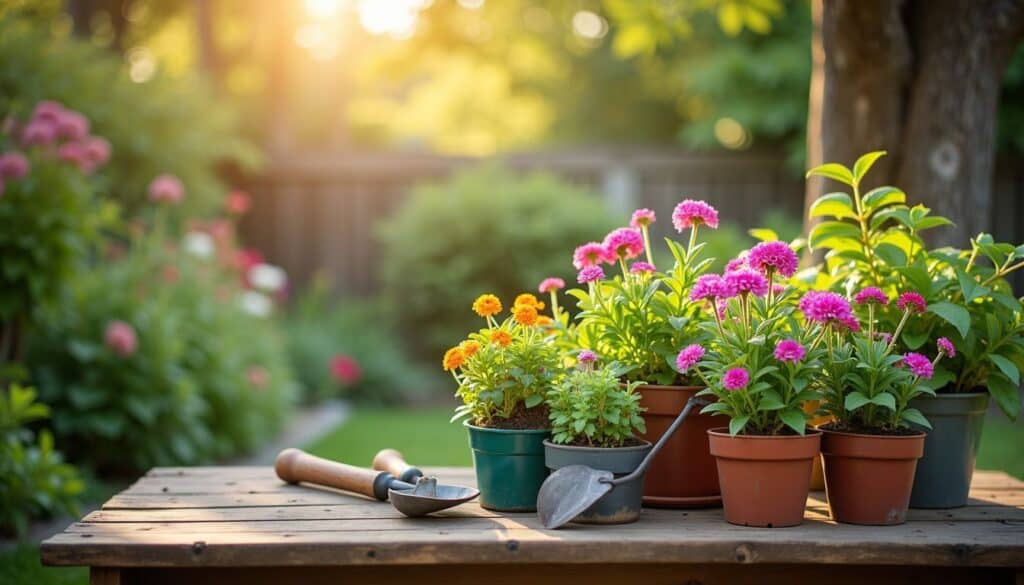
Designing your garden layout is like playing a fun puzzle game. You’ll mix and match plants, figure out where everything fits best, and create your own green oasis. Want to learn more tricks to make your garden pop? Keep reading!
Strategies for efficient space utilization
Space is gold in gardening. Smart guys know how to make the most of it. Vertical gardening is a game-changer. Use trellises to grow vines up, not out. This frees up ground for other plants.
Group similar plants together. Herbs, lettuces, and cabbages often play nice as neighbors. It’s like a plant party where everyone gets along!
Don’t forget about paths. They’re not just for looks. Good paths let you reach all your plants easily. No more stepping on your precious veggies! For raised beds, here’s a cool trick: fill the bottom half with logs or sticks.
It cuts down on soil needed and saves cash. Plus, it’s a great way to use yard waste. 10
A garden is a grand teacher. It teaches patience and careful watchfulness; it teaches industry and thrift; above all it teaches entire trust. – Gertrude Jekyll
Gathering Essential Gardening Tools
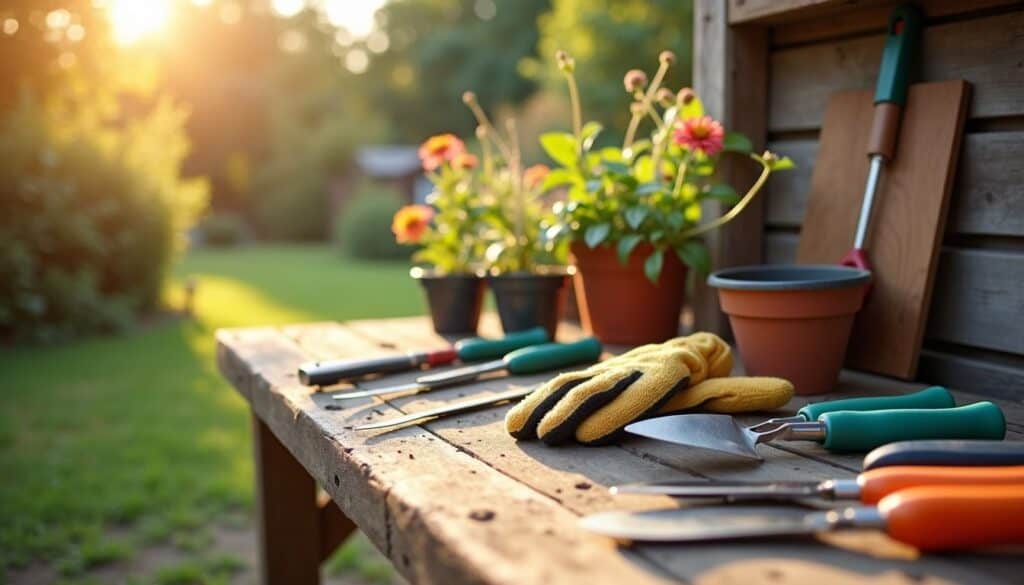
Grab your spades and trowels – it’s time to gear up! Having the right tools makes gardening a breeze. Want to know which ones you really need? Keep reading….
List of basic tools required for gardening
Ready to dig in? Let’s talk tools. You’ll need a few key items to get your garden growing. First up, grab a pair of hand pruning shears. These babies are perfect for snipping dead flowers and trimming unruly plants. 12 Don’t forget a sturdy garden shovel – it’s your best friend for digging holes and moving soil around.
Watering is crucial, so snag a watering can and hose. They’ll keep your plants happy and hydrated. For comfy planting sessions, pick up a garden kneeler and hand trowel. Your knees and back will thank you later. 13 With these tools in your arsenal, you’ll be well-equipped to tackle any gardening task that comes your way.
Initiating Seed Growth Indoors
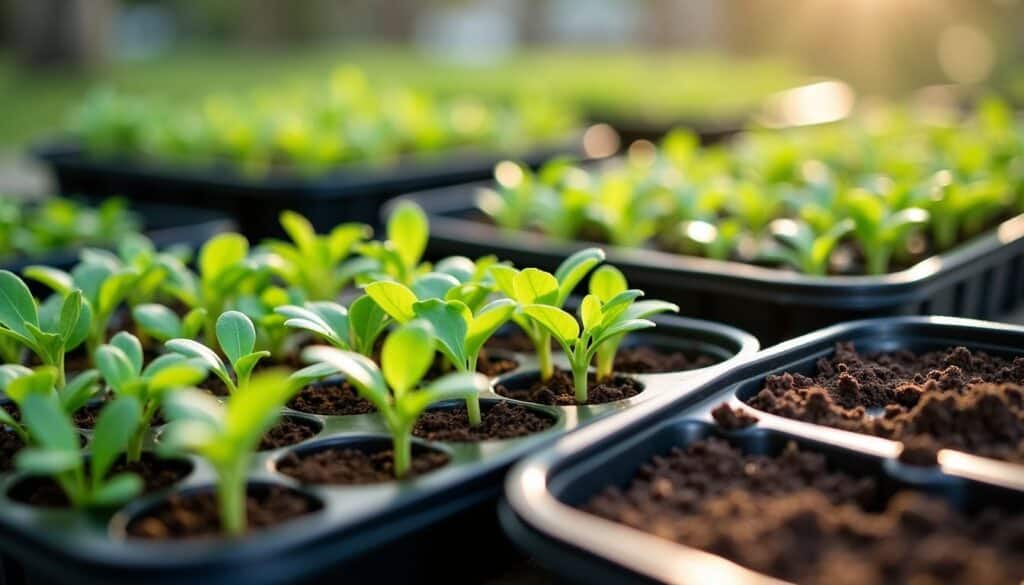
Starting seeds indoors gives your plants a head start. It’s like sending your garden kids to preschool before the big outdoors.
Timing and methods for starting seeds indoors
Starting seeds indoors is a great way to get a jump on the growing season. Most seed packets tell you when to plant. For Black Cherry tomatoes, start them inside 6-10 weeks before the last frost.
This gives your plants time to grow strong before moving outside. 14
There are a few ways to start seeds indoors. You can use small pots, seed trays, or even make soil blocks. Soil blocks are cool because they help reduce shock when you move plants outside.
If you live somewhere cold, try using a seedling heat mat. It keeps the soil warm and helps seeds sprout faster. Don’t forget to give your baby plants plenty of light once they pop up! 15
Steps for transplanting seedlings outdoors
Time to move those baby plants outside! First, toughen them up. Set seedlings outdoors for a few hours each day, slowly increasing time over a week. 15 This helps them adjust to the great outdoors.
Next, pick a spot with good sun and rich soil. Dig a hole a bit bigger than the plant’s roots. Gently place the seedling in, fill with soil, and pat down. Give it a good drink of water to help it settle in.
Your little green friends are now ready to grow big and strong!
Make sure the soil is moist but not soggy. Too much water can drown your plants. Keep an eye on them for the first few days. They might look a bit sad at first, but don’t worry. That’s normal as they get used to their new home.
If it’s super hot or windy, give them some shade. 16 A bit of mulch around the base can help keep moisture in. Soon, you’ll see new growth… and before you know it, you’ll have a thriving garden!
Guidelines for proper plant spacing and depth
Proper plant spacing and depth are key to a thriving garden. Give your green buddies room to stretch! Most veggies need 6-12 inches between plants. 17 Tomatoes? They’re social distancers – keep ’em 2-3 feet apart.
As for depth, a good rule of thumb is to plant seeds twice as deep as their size. Big seeds like beans go deeper, while tiny carrot seeds barely need a dusting of soil. I once crammed too many zucchinis in a small space…
Let’s just say I learned my lesson the hard way!
Getting your spacing right isn’t just about looks. It’s crucial for plant health and yield. Crowded plants compete for nutrients, water, and sunlight. They’re also more prone to diseases.
On the flip side, too much space wastes valuable garden real estate. Finding that sweet spot takes practice, but it’s worth it. Trust me, your plants will thank you with a bountiful harvest. 18 Speaking of rewards, let’s dive into the joys of gardening and explore how to manage water in your garden.
Water Management in the Garden
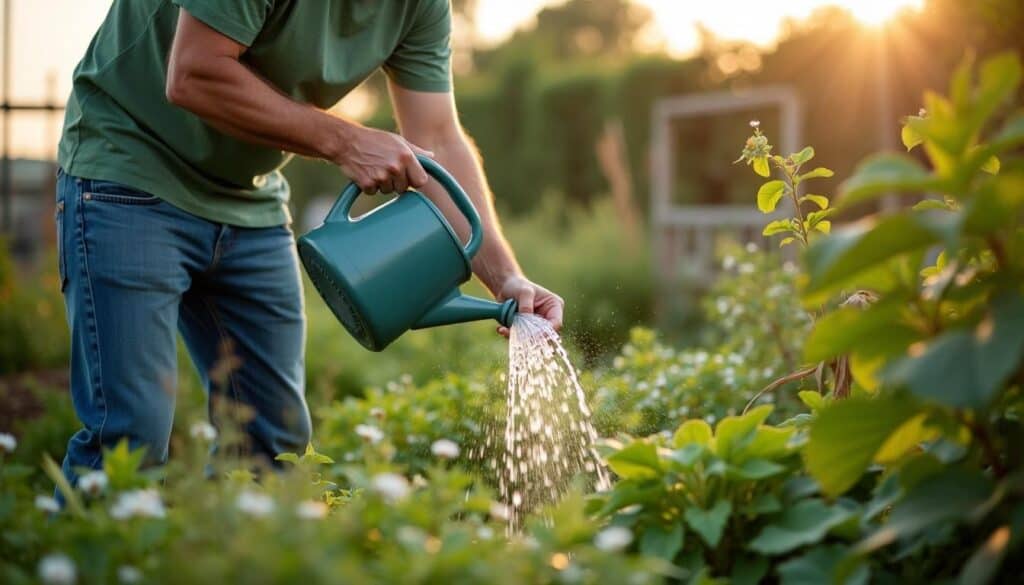
Watering your garden isn’t rocket science, but it’s not child’s play either. Get it right, and your plants will thrive – get it wrong, and you might as well kiss your green dreams goodbye.
A good soaker hose or drip irrigation system can be a game-changer, saving you time and keeping your plants happy.
Guidelines for watering plants effectively
Water is the lifeblood of your garden. Give your plants a deep drink less often, rather than frequent shallow sips. This helps roots grow deeper and stronger. I learned this the hard way when I nearly killed my tomatoes with daily sprinkles.
Now, I stick my finger in the soil – if it’s dry two inches down, it’s time to water.
Climate plays a big role in how you water. In hot, dry areas, you might need to water more often. Rainy regions? Less so. Adding soil³ compost to your beds can help hold moisture longer. 19 Don’t fret about watering only in the morning – I’ve had great success giving my thirsty plants a drink any time of day. 20 Just aim for the roots, not the leaves, to avoid fungal issues.
Applying Mulch and Controlling Weeds
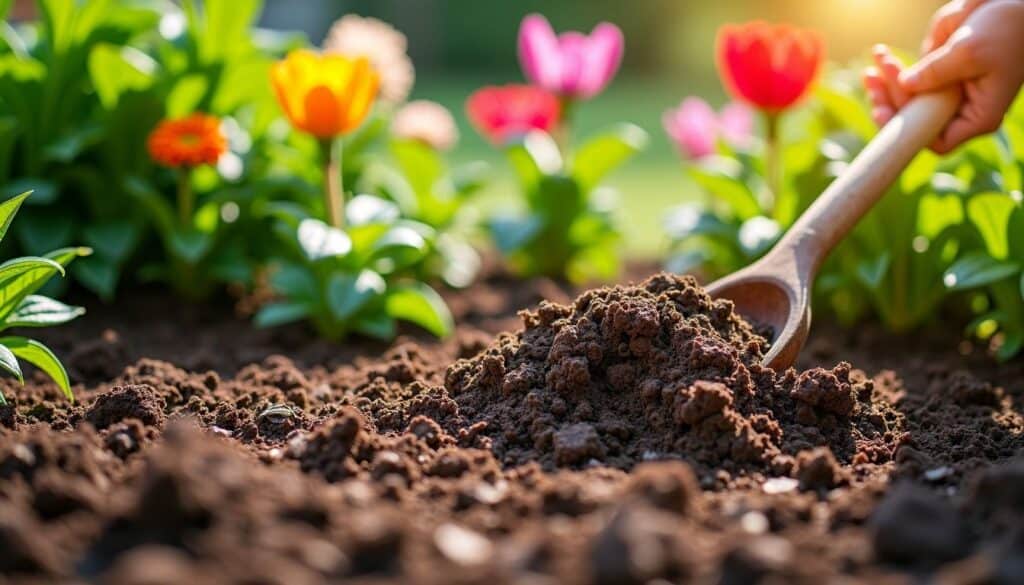
Mulch is your garden’s best friend. It keeps weeds at bay and holds moisture in the soil. Want to know more about this magic layer? Keep reading!
Choosing the right type of mulch
Picking the perfect mulch can make or break your garden. Organic options like compost, straw, and leaves are top choices. They break down over time, feeding your soil with good stuff. 21 But watch out! If you use grass clippings, make sure they’re not treated with weed killers. Those chemicals can hurt your veggies.
Plastic mulch is another option. It’s great for keeping weeds at bay, but you’ll need to be smart about watering. Water can’t always get through easily. Straw mulch is popular too, but it comes with its own issues.
It might bring in bugs you don’t want, and sometimes it carries weed seeds. Next up, let’s talk about how to put that mulch to work and keep those pesky weeds under control. 22
Effective weed management techniques
After picking the right mulch, it’s time to tackle those stubborn weeds. Mulch helps, but it’s not a fix-all solution. You’ll need a strategy to keep your garden weed-free. Start early – catch those weeds before they spread.
A combo of mulching and hand-pulling often works best. 23 Natural mulches like straw or wood chips not only block weeds, but also nourish your soil. For tough annual weeds, try black plastic.
It’s not pretty, but it’s effective.
Don’t skip weeding early in the season. It’ll save you loads of time later. Pull weeds when the soil is damp – they’ll come out easier, roots and all. For bigger areas, a hoe can be super helpful.
Cut through weed roots just below the soil surface. Be careful around your plants, though. You don’t want to damage their roots. Regular weeding keeps your garden looking great and your plants thriving.
They won’t have to fight for water and nutrients. Your veggies and flowers will reward you with a great harvest. 24
Managing Pests and Diseases
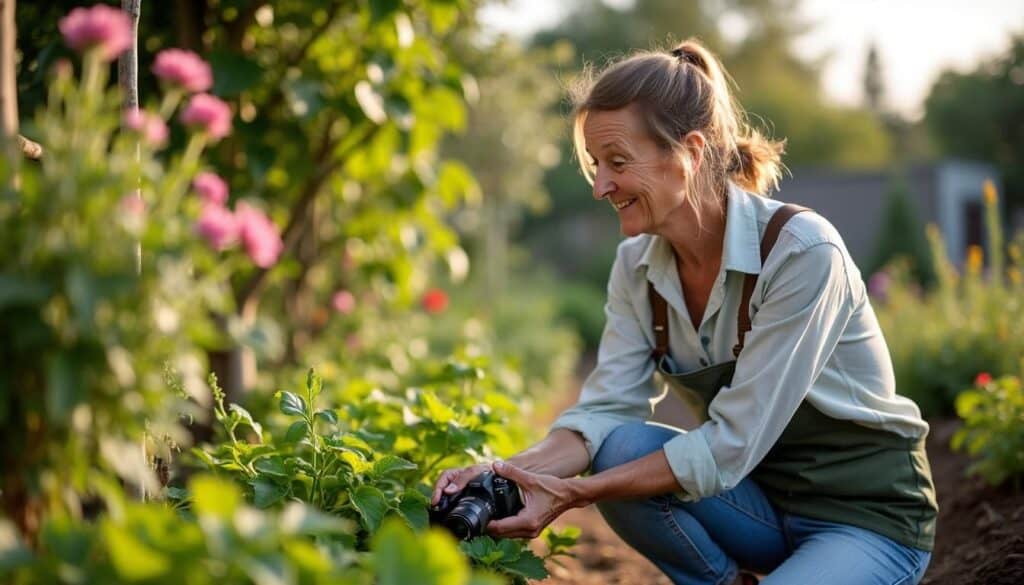
Bugs and plant sicknesses can ruin your garden fast. But don’t worry – there are easy ways to keep your plants healthy and pest-free. Want to learn how? Keep reading!
Identifying common garden pests and diseases
Bugs and diseases can wreck your garden fast. Keep a sharp eye out for trouble. Look for chewed leaves, wilting plants, or weird spots. Common pests include aphids, slugs, and caterpillars.
They munch on your veggies and flowers. 26 Plant diseases like powdery mildew or blight can spread quick. They leave marks or make plants sick. 25
Don’t panic if you spot issues. Many problems have simple fixes. Knock off aphids with a strong spray of water. Pick off slugs by hand (gross, but effective). For diseases, remove affected parts ASAP.
Good air flow helps prevent spread. Regular checks catch problems early. That’s key to keeping your garden healthy and thriving.
Integrating organic and chemical treatment solutions
Organic and chemical treatments can work together to keep your garden healthy. Start with natural methods like neem oil or helpful bugs to fight pests. These tricks often do the job without harsh chemicals. 28 But sometimes, you might need stronger stuff. That’s when carefully chosen pesticides come in handy. Just use them sparingly and follow the instructions on the label.
A smart mix of both approaches is key. Rotate your crops and plant companion plants to naturally ward off pests. If problems persist, spot-treat with chemicals as a last resort. 27 This balanced strategy keeps your plants happy and your garden thriving.
Next up, let’s talk about how to keep your garden in tip-top shape all year round.
Garden Maintenance Practices
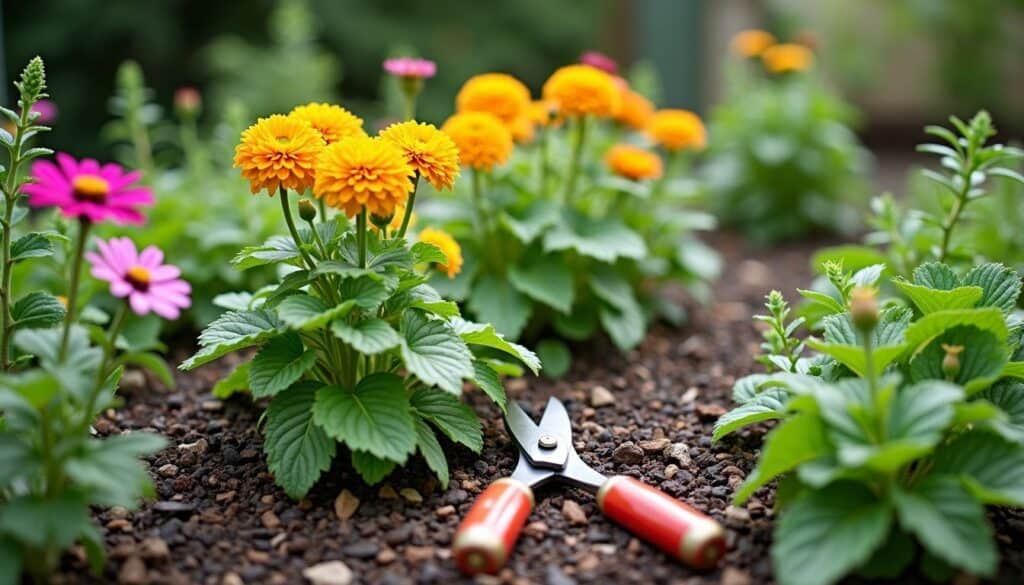
Regular pruning and smart harvesting keep your garden thriving… but there’s more to it than just snipping away. Want to learn the secrets of year-round garden care? Keep reading!
Tips for pruning and harvesting regularly
Pruning and harvesting are key to a thriving garden. Grab your shears and get snipping! For most plants, cut back about a third of the growth. This keeps them healthy and shapely. But watch out – too much pruning can hurt your green pals. 29 For veggies, pick often to boost yields. Tomatoes and beans love frequent harvests. It tells the plant to make more goodies for you. 30
Don’t forget your perennials come fall. After they bloom, give ’em a good trim. It helps them survive winter and come back strong next year. 29 Two main pruning types exist: heading cuts and thinning cuts.
Heading shortens branches, while thinning removes whole limbs. Mix it up for the best results. Your plants will thank you with lush growth and bountiful harvests.
Guidance for seasonal garden care
Seasonal garden care keeps your green space thriving year-round. In spring, prep your soil and plant new seeds. Summer calls for regular watering and pest control. 18 Fall’s the time to harvest and add compost.
Winter? That’s when you plan and maintain tools. Each season brings its own tasks, but they’re all part of the fun. I’ve found that keeping a garden journal helps track what works best in my yard.
Don’t forget to adjust your care as the weather shifts. Less water in fall and winter, more in summer. Prune plants when they’re dormant – usually late winter or early spring. And always keep an eye out for pests…
they love to sneak in when you least expect it! Trust me, I’ve battled my fair share of sneaky bugs. But with a bit of care and attention, your garden will bloom beautifully all year long. 31
Harvesting Your Garden Produce
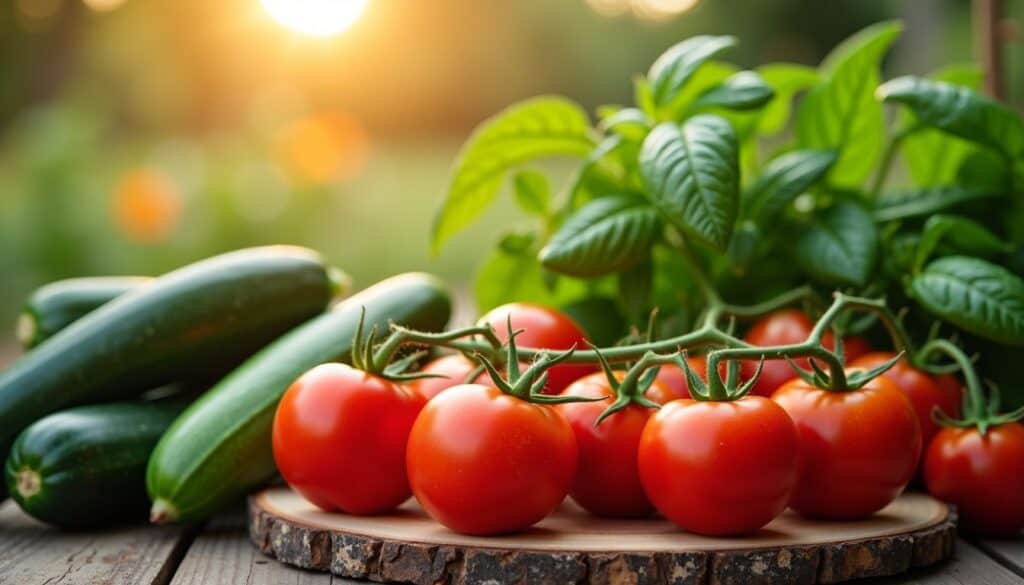
Picking your homegrown goodies is the best part of gardening! It’s like Christmas morning every time you step into your garden. You’ll learn when to pluck those juicy tomatoes and how to snip herbs just right.
Ready to dig in? Keep reading for more green thumb secrets….
Indicators for when plants are ready to harvest
Knowing when to pick your veggies is key to tasty meals. For quick growers like radishes, just pull ’em up when they look big enough for your salad. 32 Spuds take a bit longer – about 10 to 12 weeks after planting, you can start digging for those yummy new potatoes.
Got peppers or tomatoes? Wait until they show even color all over. That’s your green light to start harvesting.
Fruit trees need a different approach. Take apples and pears, for instance. Give ’em a gentle twist. If they come off easily, they’re ready to eat. It’s like they’re saying, “Pick me!” Trust your gut (and your eyes) when harvesting.
With practice, you’ll get a feel for it. Soon, you’ll be plucking perfect produce like a pro. 33
Harvesting techniques for various plants
Picking your homegrown veggies is like unwrapping presents – exciting and rewarding! For broccoli, try the Di Cicco variety. It’s great. Cut the main head when it’s tight and green.
Keep the plant after – side shoots will continue growing. Peppers and tomatoes? Start them indoors for best results. Pick peppers when they’re firm and colorful. Tomatoes should feel heavy and smell great.
Here’s a tip: space out your plantings. It’s the key to continuous harvests all season long. 34
Want more value? Try Charles Dowding’s multi-sowing method. It works wonders for leafy greens and root crops. Plant several seeds in one spot, then thin them out as they grow. You’ll get waves of fresh produce without extra effort.
Just note – timing matters. Watch your plants and harvest often. Fresh, crisp veggies are much better than overripe, soft ones. Your taste buds will love it! 31
People Also Ask
What’s the secret to great soil for my garden?
Mix potting soil, organic matter, and a dash of vermiculite. This combo gives your plants a cozy home. Add some mycorrhizae for extra oomph. Your veggies will thank you!
How do I start a vegetable garden from scratch?
First, pick a sunny spot. Then, test your soil’s pH. Toss in some organic mulch and topsoil. Plant your seeds or seedlings. Water them like they’re thirsty camels. Watch ’em grow!
Can I grow plants indoors if I don’t have a yard?
You bet! Grab some pots, potting mix, and indoor-friendly plants. Put ’em near a window for sunlight. Keep the humidity up. Soon, you’ll have a mini jungle in your living room!
What’s companion planting and why should I care?
It’s like matchmaking for plants! Some veggies grow better together. For example, tomatoes and basil are BFFs. This trick boosts growth and keeps pests away. It’s nature’s teamwork!
How do I start plants from seeds?
Get seed packets and potting soil. Plant the seeds in small containers. Keep them warm and moist. When sprouts pop up, move them to a sunny spot. It’s like being a plant parent!
What tools do I need to start gardening?
You don’t need much! Grab a trowel, gloves, and watering can. If you’re feeling fancy, get a rototiller for bigger plots. Don’t forget a hat – gardening’s an outdoor sport!
References
^ https://www.dripworks.com/blog/how-to-select-the-location-for-your-garden?srsltid=AfmBOorSXcyS1yU8yTNjjR4sKnV7pR4Ox5M6m75iBoZiHTIrVNjW0Rd- (2024-04-17)
^ https://www.dripworks.com/blog/how-to-select-the-location-for-your-garden?srsltid=AfmBOooW02QBuSoB8jO3GnL2ApR7CX03ZUaO-a7-sMvz-g-dVLeOlAOZ (2024-04-17)
^ https://permies.com/t/100387/choose-vegetables-garden (2019-01-14)
^ https://www.greenthumb.com/gardening-for-a-healthy-life-style/?srsltid=AfmBOor0Crkt0jvqi8uXb3vL_emEzep4E87XmYSOk1eUv_3X-OwqEUdb (2019-04-17)
^ https://gratsi.com/blogs/all/homesteading-series-how-to-choose-plants-for-your-first-garden?srsltid=AfmBOor2vrTPkBsh2PuTZ9Bin-Nug0BRO0wWg0-NpnFj_LRP_Y5ZzVVs (2024-04-16)
^ https://www.gardenary.com/blog/how-to-start-a-garden-part-8-understanding-your-climate (2024-05-13)
^ https://biomemakers.com/complete-guide-to-soil-testing
^ https://flowerbuzz.org/basics/in-gardening/ (2023-09-12)
^ https://www.gardenary.com/blog/growing-in-a-raised-garden-bed-versus-in-ground-gardening (2022-10-11)
^ https://www.gardenary.com/blog/how-to-start-a-garden-part-2-creating-a-garden-design (2024-04-10)
^ https://www.dearavantgardener.com/articles/how-to-create-a-garden-layout (2023-05-16)
^ https://www.washingtonpost.com/home/2023/02/28/essential-garden-tools/ (2023-02-28)
^ https://www.gardendesign.com/how-to/tools.html
^ https://www.theseasonalhomestead.com/indoor-seed-starting-guide-what-no-one-tells-you/
^ https://fordragonfliesandme.com/2024/02/08/the-green-thumbs-guide-to-successful-seed-starting/
^ https://joegardener.com/podcast/how-to-start-care-for-seedlings-indoors/
^ https://www.youtube.com/playlist?list=PLuk5ZHHXCFbxF2RP2girwmnEYTaH7lhe1
^ https://greenthumbgardeningsecrets.com/
^ https://blog.soil3.com/best-practices-watering-garden (2020-08-18)
^ https://homesteadingfamily.com/best-time-to-water-garden/ (2021-08-21)
^ https://www.iamcountryside.com/growing/best-mulch-to-prevent-weeds/
^ https://www.grassperson.com/blog/how-to-choose-best-mulch-for-weed-control-landscaping-beds (2024-04-22)
^ https://hgic.clemson.edu/factsheet/controlling-weeds-by-cultivating-mulching/
^ https://mikesbackyardnursery.com/2013/07/how-to-get-rid-of-and-or-control-weeds/
^ https://www.amazon.com/Home-Gardeners-Garden-Pests-Diseases/dp/1580117554
^ https://piedmontmastergardeners.org/article/eleven-common-garden-pests-identification-and-management/
^ https://www.motherearthgardener.com/organic-gardening/plan-for-less-pests-with-integrated-pest-management-zb0z1802/ (2018-02-15)
^ https://www.gardenary.com/blog/organic-ways-to-treat-pests-in-a-vegetable-garden
^ https://gardenprofessors.com/pruning-basics/ (2021-09-17)
^ https://wvpm.ca/blog/f/green-thumb-secrets-essential-garden-maintenance-tips-and-tricks
^ https://www.youtube.com/watch?v=IZ5-Mz_Ivec
^ https://www.youtube.com/watch?v=8gCt675555o
^ https://rootsandrefuge.com/how-to-harvest-vegetables/ (2022-08-17)
^ https://forksinthedirt.com/water-wise-harvesting-from-your-garden/
